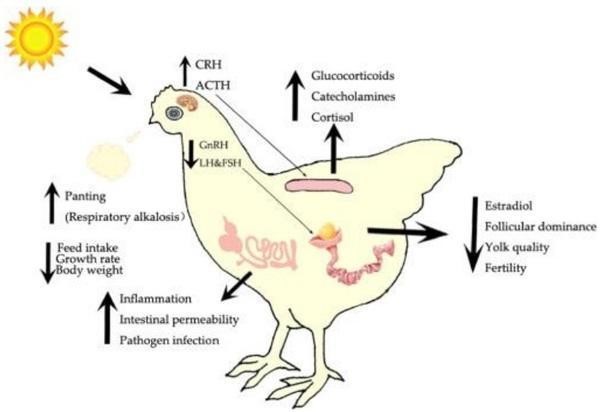
Poultry
Folliculogenesis in Poultry
In the global poultry industry, egg-laying production efficiency is a key economic factor. High productivity is determined by the number of ovarian follicles preparing for ovulation and the efficiency of the oviduct in converting ova into hard-shelled eggs. However, increasing the number of ovarian follicles involves several factors, including nutritional, pathological, managerial, and climatic influences. Before discussing available solutions to boost farm productivity and meet standard production parameters, it’s important to first understand the anatomy and physiology of the bird.
ANATOMY & PHYSIOLOGY OF CHICKEN REPRODUCTIVE SYSTEM
The reproductive system of a chicken hen consists of two main parts: the ovary and the oviduct. The ovary develops multiple yellow pouches called ova (yolks). Once an ovum (singular for ova) matures, it is released from the ovary into the oviduct—a process known as ovulation (illustrated in Figure 1). It takes approximately 25 to 26 hours for the hen’s body to transform a yolk into a fully formed egg and lay it. Typically, around 30 to 75 minutes after laying an egg, the ovary releases the next ovum.
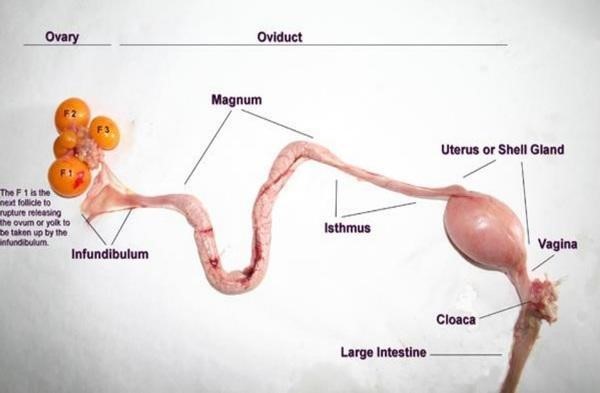
Fig 1: Reproductive tract of laying hen
Throughout the egg formation process, various sections of the oviduct each play a specific role, ultimately leading to the complete formation of the egg. Let’s explore the different parts of the oviduct and their functions.

FOLLICULOGENESIS IN POULTRY
Folliculogenesis is the process of developing or maturing the ovarian follicle, which is a densely packed cluster of somatic cells containing an immature oocyte. This process describes the progression of numerous small primordial follicles into large pre-ovulatory follicles, occurring in stages throughout the ovulatory cycle. In laying hens, follicle development follows a well-organized hierarchy (see Fig. 2).

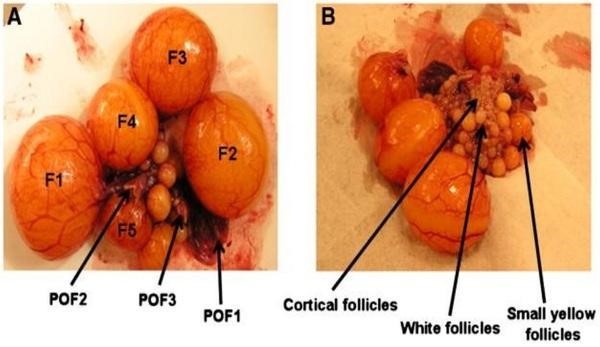
Fig 2: Follicle hierarchy POF1, POF2 & POF3
Pre-hierarchical follicles are smaller follicles categorized by size as follows:
- Small white follicles (SWF; less than 1 mm)
- Large white follicles (LWF; 2–4 mm)
- Small yellow follicles (SYF; 4–8 mm)
- Large yellow follicles (LYF; 8–40 mm)
Hierarchical follicles, found just before ovulation, number around 5–6 and measure over 10 mm in diameter. Once mature, these follicles become ovulatory and contribute to egg formation. Notably, birds with lower reproductive efficiency lack this distinct follicular hierarchy. In chickens, only the left ovary is functional anatomically and physiologically.
The right ovary is present during embryonic development, but by day 4 of incubation, the distribution of primordial germ cells becomes asymmetrical, with the right ovary beginning to regress by day 10.
An immature bird’s ovary contains nearly 2,000 small oocytes, but only 200–500 will mature and ovulate within the production period.
Follicle Growth:
The single left ovary contains follicles of various sizes and developmental stages, including cortical primordial follicles, white follicles, and large yolk-filled follicles (see Fig. 2) that have been recruited into a well-organized preovulatory hierarchy. Follicle growth progresses as follows: from 3 to 5 mm in 3 days, from 5 to 8 mm in 2 days, and from 8 mm to ovulation (40 mm) in 6 days (Gilbert et al., 1983). The entire development process, from 1.5 mm to 40 mm, takes about 17 days (Perry et al., 1983).
Yolk formation occurs in the liver and is stimulated by gonadotropin and steroid hormones. The yolk protein precursor, vitellogenin, is transported via the blood to the ovary, where it is broken down into two yolk proteins, lipovitellin and phosvitin (Deely et al., 1975). Triglycerides are transported to the yolk in the form of β-lipoproteins and later integrated into the yolk as lipid globules. During most of the growth phase, lipids and proteins are deposited in equal proportions into the developing follicle. However, in the final rapid growth phase, relatively more lipid is incorporated. Consequently, the yolk in a hen’s egg has a higher lipid content (33% of wet weight) compared to protein (16% of wet weight).
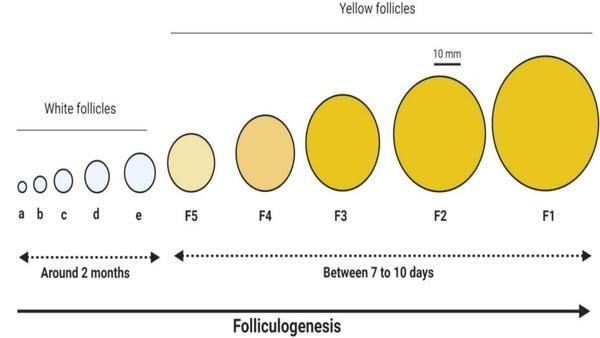
Fig 3: Sequence of Vitellogenesis
Hormonal regulation for follicle development
In hens, follicle-stimulating hormone (FSH) is responsible for the selection and development of granulosa cells in small follicles. FSH primarily acts on the granulosa layer of small yellow follicles and the sixth (F6) to third (F3) largest follicles, also promoting progesterone production within granulosa cells in these F6 to F3 follicles. Although luteinizing hormone (LH) in hens does not luteinize follicles, it plays a crucial role in ovulation and steroidogenesis. LH primarily targets the larger preovulatory follicles (see Fig. 4).
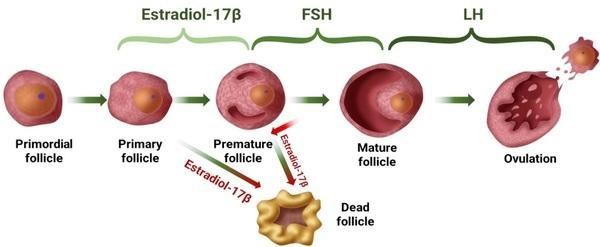
Fig 4: Hormonal regulation for follicle development
Relationship between folliculogenesis and egg production
Broiler breeds from different breeders (Table 1) are underperforming compared to their breed-specific standards, creating a notable gap between actual performance and expected benchmarks. Various challenging factors contribute to the difficulty of closing this gap.
Table 1: Different Broiler breeder specifications
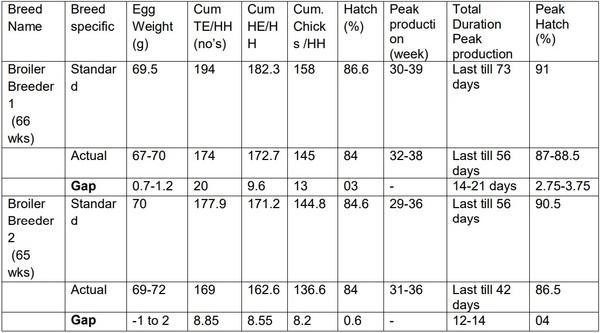
This gap may result from visible factors such as climate, pathogens, nutrition, and management, all of which are directly controlled by poultry entrepreneurs. These elements are crucial to breeder hen performance and are key for successful broiler breeding. However, the effectiveness of these factors relies heavily on underlying, less visible influences like hormonal imbalances and cellular damage from oxidative stress (see Fig. 5). Reactive Oxygen Species (ROS) reduce reproductive performance in layers, as evidenced by lower egg-laying rates, decreased hormone levels (including estradiol, FSH, and LH), a smaller reserve of primordial follicles, and an increased number of dead follicles in the ovaries of affected layers.

Fig 5: Factors responsible for oxidative stress
IMPORTANCE OF REPRODUCTIVE HEALTH
Profitability in poultry breeding largely depends on the reproductive health of the birds, as it impacts multiple key functions, including:
- Flock uniformity, which supports the proper development of reproductive organs and timely maturity of the birds.
- Optimal reproductive health, which results in both high-quality and high-quantity egg production.
- The entire egg formation process occurs within the reproductive organs, making their health essential.
- A healthy reproductive system promotes a strong hormone surge.
- Better reproductive health reduces the number of dead follicles and non-laying birds in the flock, supporting a robust folliculogenesis process.
- A healthy reproductive system also minimizes the clutch period.

















Add your comment